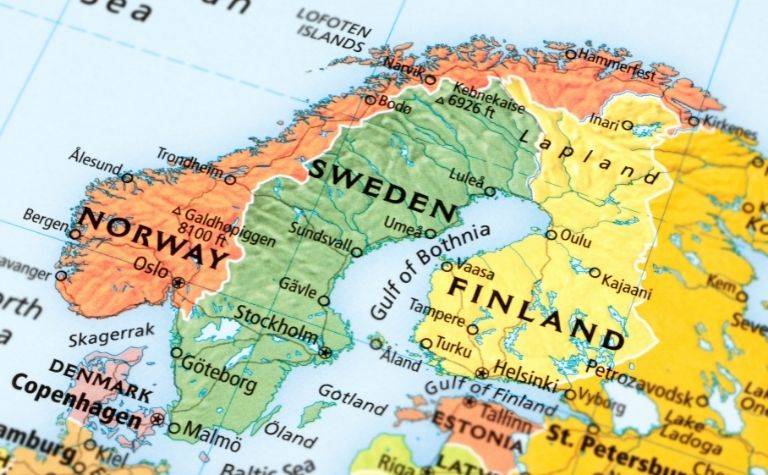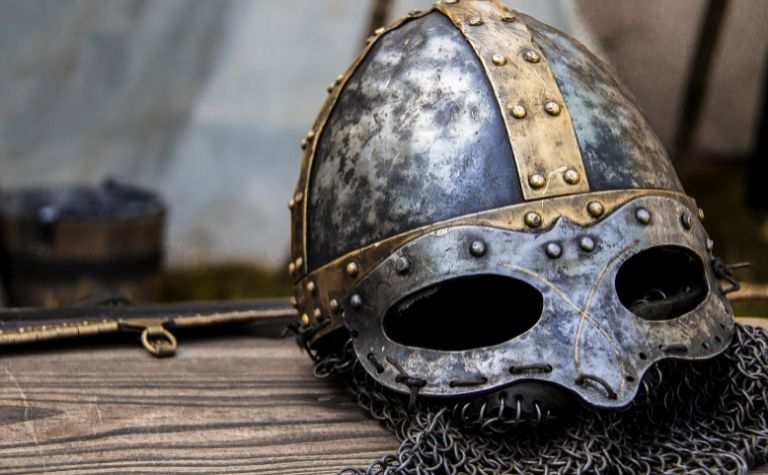People today are fascinated with the Vikings. Popular depictions of them in entertainment media have raised questions for many people about what they looked like, how they fought, and how they lived.
Another question people ask about them is their ethnic heritage. Some people wonder if they were from Germany.
Vikings weren’t German. While there were eventually Viking settlements in many places, including Britain, France, and even Asia, Vikings were Scandinavian.
They came primarily from Denmark, Norway, and Sweden. Many eventually settled in Iceland and Greenland, as well.
This article will further explore the origins of the Vikings, including their race and skin color. It will also outline the differences between the terms Norse and Germanic.
Also see Exploring Viking Ranks and Classes to learn more.

Where Were Most Vikings From, And Where Did They Settle?
Most Vikings came from Denmark and Norway, though some came from other Scandinavian countries.
They settled in numerous places all over Europe, including Wessex, Iceland, Wales, Scotland, Ireland, England, etc. Rollo, a famous Viking leader, even led Vikings to Normandy, where he became a duke.
The Vikings also raided many countries and settlements in places as far away as North America, Baghdad, and Constantinople. [1]
What Race Were Vikings?
Vikings were primarily white Europeans from the Scandinavian countries, though current science has proven that this wasn’t exclusively the case.
According to modern DNA testing, some Vikings had Southern European, Asian, and even Indigenous heritage.
DNA testing, research, and study have come a long way in the last few decades.
Thanks to these improvements, scientists can learn more about history than ever before.
One thing they’ve discovered is that Vikings were a multi-racial and multicultural group of people. [2]
Much of this diversity came from the Vikings’ travels. [3]
They were seafarers who traveled as far as Asia and the Americas, and they came in contact with many people of different races.
They took some of these people back as slaves and made others their wives or lovers.
Both of these things introduced new DNA into the Vikings’ primarily Scandinavian roots.
Additionally, the Vikings had a society where enslaved people could sometimes be freed.
This would happen if a Viking fell in love with a slave or became otherwise fond of them. Additionally, slaves who proved themselves worthy warriors might be freed.
Either way, they became “Vikings,” though nothing about their heritage was Scandinavian or European.
In that respect, Vikings was less a designation of race and heritage than it was culture.
A Live Science article from 2020 talks about two unearthed male skeletons in a Viking burial site: “They were buried with swords and other Viking items, but they weren’t actually Vikings, but rather genetically similar to modern-day Irish and Scottish people.” [4]
Also see Were the Vikings Literate? to learn more.

What Skin Color Were Vikings?
Because most Vikings had Scandinavian heritage, they primarily had white or fair skin.
However, since some Vikings had Asian or Indigenous heritage, there were likely some darker-skinned Vikings, as well.
Furthermore, some Viking slaves, including those of color, became legitimate Vikings.
Since Vikings came from such diverse backgrounds and could be former slaves, there’s no limit to how they could look.
However, most people’s typical image of Vikings is pretty accurate for those of Scandinavian descent.
The National Museum of Denmark describes Vikings as being more muscular versions of modern-day citizens of Denmark. [5]
They were likely near the same height but probably had more muscles and tone because of the hard work they had to do just to stay alive.
Additionally, many were fair-skinned with blonde or red hair.
Specifically, West Scandinavian Vikings probably had red hair, while those from North Scandinavia were more likely blonde.
Both men and women wore their hair long, and men often had elaborate beards and mustaches.
Additionally, there was less of a distinct difference between males and females.
The women’s brow ridges were more prominent than women today, making them look a bit more masculine.
In contrast, the men had softer jawlines and less prominent brows, making them appear slightly more feminine than men today.
Both male and female Vikings of Scandinavian heritage likely had pale or ruddy skin.
As for Vikings outside of Scandinavia or those with mixed heritage, they could have looked like anything.
Their skin tones could have ranged from pale white to dark black and covered every shade in between.
Similarly, their hair colors likely included the entire scope of natural hair colors.
Also see Did the Vikings Celebrate Birthdays? to learn more.

Are Norse and Germanic the Same?
Norse and Germanic aren’t the same, though there’s overlap between them.
For example, all Norse people were Germanic, but not all Germanic people were Norse.
The term Germanic is commonly applied to languages. English is a Germanic language, so Americans are also Germanic-speaking people.
Many people have a problem with the term Germanic because they think it means someone is from Germany. That’s not the case.
Dictionary.com lists four definitions for the word Germanic, and only one of them relates specifically to Germany; the other three definitions concern languages.
A summary of these definitions is as follows:
- A branch of the Indo-European family of languages
- The unrecorded Proto-Germanic language
- Denoting or relating to the Germanic group of languages
- Of, relating to, or characteristic of Germany, the German language, or people who speak a Germanic language [6]
By these definitions, people from many areas of the world could be considered Germanic.
On the other hand, Norse focuses on a particular group of people and their language and culture. Norse people are those from Scandinavia.
Because of their languages, they’re also a Germanic people, even though they aren’t from Germany.
Many Germanic people have no ties to Scandinavia, though.
The one thing Norse people and ancient Germans do have in common is a belief in the Norse gods.
Early Germans had polytheistic beliefs that included worshiping the Norse gods.
However, they didn’t worship Odin, Thor, and the other Aesir exclusively.
They also incorporated elements of Continental Germanic mythology and Anglo-Saxon mythology into their beliefs. [7]
Conclusion
Vikings weren’t German; they were Scandinavian. However, they were Germanic-speaking people because of their languages. They also shared religious beliefs with early Germans.
Also see How Did the Vikings Treat Their Wives? to learn more.
References:
[1] Source
[2] Source
[3] Source
[4] Source
[5] Source
[6] Source
[7] Source
